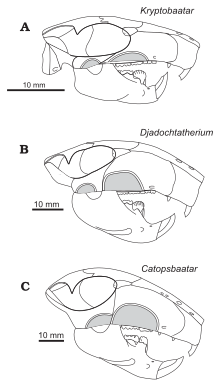Djadochtatherioidea
Appearance
| Djadochtatherioidea Temporal range:
| |
|---|---|

| |
| Various skulls | |
| Scientific classification | |
| Domain: | Eukaryota |
| Kingdom: | Animalia |
| Phylum: | Chordata |
| Class: | Mammalia |
| Order: | †Multituberculata |
| Suborder: | †Cimolodonta |
| Superfamily: | †Djadochtatherioidea Kielan-Jaworowska and Jørn Hurum, 2001 |
| Clades | |
Djadochtatherioidea is a superfamily of
mammals known from the upper Cretaceous and Paleocene[1] of what is now Central Asia, North America and Europe. They were members of the order Multituberculata. These were very ecologically diverse; several were jerboa-like hoppers,[2] while others like Mangasbaatar were large sized and fossorial.[3] Unusually for multituberculates, some of this group are represented by very good remains. All upper Cretaceous Mongolian multituberculates are included with one exception, the genus Buginbaatar
.
This superfamily is further subdivided into three families and several other
suborder of Cimolodonta
.
Djadochtatherioidea was established by Zofia Kielan-Jaworowska and Jørn Hurum in 2001 as a replacement for the previously proposed Djadochtatheria that they had proposed in 1997. Shared characteristics of the group are
Notes
- ^ Smith, Thierry; Codrea, Vlad A.; Devillet, Ghéreint; Solomon, Alexandru A. (2021-09-24). "A New Mammal Skull from the Late Cretaceous of Romania and Phylogenetic Affinities of Kogaionid Multituberculates". Journal of Mammalian Evolution. 29: 1–26. doi:10.1007/s10914-021-09564-7. ISSN 1064-7554. S2CID 244194193.
- ^ Rougier et al 2016
- ^ Rougier et al 2016
- ^ Kielan-Jaworowska and Hurum 2001, pp 416-417
References
- Chen, Meng; Wilson, Gregory P. (2015). "A multivariate approach to infer locomotor modes in Mesozoic mammals". Paleobiology. 41 (2): 280–312. S2CID 86087687.
- Dykes, Trevor. "Mesozoic Mammals; Djadochtatherioidea, an internet directory". Archived from the original on 21 April 2003.
- Kielan-Jaworowska, Zofia; Hurum, J.H. (2001). "Phylogeny and Systematics of Multituberculate Mammals". Palaeontology. 44 (3): 389–429. .
- Rougier, Guillermo W.; Amir S. Sheth; Barton K. Spurlin; Minjin Bolortsetseg; Michael J. Novacek (2016). "Craniodental anatomy of a new Late Cretaceous multituberculate mammal from Udan Sayr, Mongolia". Palaeontologia Polonica. 67: 197–248. doi:10.4202/pp.2016.67_197 (inactive 2024-02-14).)
{{cite journal}}: CS1 maint: DOI inactive as of February 2024 (link


